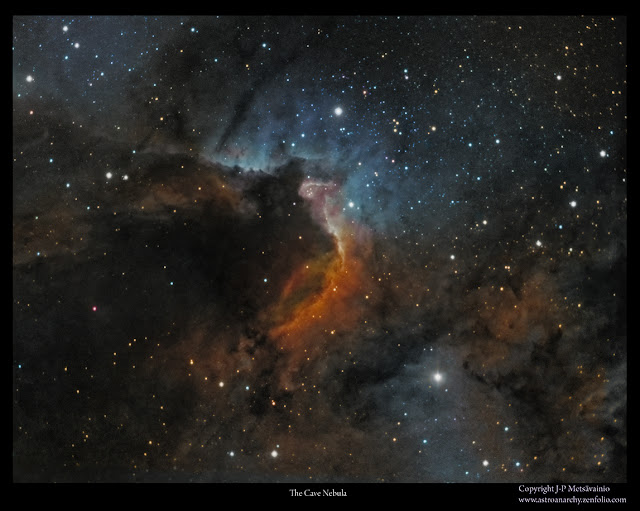COPYRIGHT, PLEASE NOTE
Tuesday, April 22, 2025
A Planetary Nebula Purgathofer-Weinberger 1 (PuWe1) is the Last Photo for Now
I spent total 36 hours of collecting 20 min. exposures for this cosmic smoke ring with narrowband filters, H-alpha, S-II and O-III. PuWe1 locates in constellation lynx at distance of about 1300 light years.
This is my last new photo for the imaging season 2024-25, we ran out of the astronomical darkens at May 7. Deep sky imaging is possible again after the first week of September. up here 65N.
PuWe1
Click for a large image, 2000 x 2000 pixels

A mapped color image from a light emitted by an ionized elements, sulfur=red, hydrogen=green and oxygen=blue. Original resolution 6500 x 6500 pixels
Click for a large image, 1600 x 1600 pixels
Two galaxies are visible at edge of the nebula at middle of the photo
Image in visual colors
Click for a large image, 2000 x 2000 pixels

The emission from H-alpha and S-II are seen as red, blueish tones are from an emission of ionized oxygen, O-III. This combination is very close to a visual colors of the nebula.
A size comparison between M27 and PuWe1
Click for a large image, 2000 x 2300 pixels

Note, a size of the Full Moon is marked as a white circle as a scale.
The apparent size of the Full Moon in the sky is 30 arc minutes (0,5 degrees)
Technical details
O-III, 6x 1200 s, binned 2x2 = 6h
Saturday, April 19, 2025
Soul Nebula, a Two Frame Panorama
I published yesterday a detail picture of the Soul nebula, IC 1848. Earlier this year I shot another long focal length photo of the IC 1848, those two photos are overlapping so I was able to make a two frame mosaic out of them, total exposure time 30h
Click for a large image, 2800 x 1700 pixels
 A mapped color image from a light emitted by an ionized elements, sulfur=red, hydrogen=green and oxygen=blue. Original resolution 8500 x 5000 pixels
A mapped color image from a light emitted by an ionized elements, sulfur=red, hydrogen=green and oxygen=blue. Original resolution 8500 x 5000 pixelsO-III, 6x 1200 s, binned 2x2 = 5h
Friday, April 18, 2025
Part of the Soul Nebula
Soul nebula, IC 1848, has been my target many times during the years. This time I have shot some details of the nebula with my current long focal length imaging system.
O-III, 6x 1200 s, binned 2x2 = 2h
Thursday, April 10, 2025
Sharpless 155, the Cave Nebula
This is one of the targets I’ve been imaging for decades using various equipment—from camera lenses (150–300mm) to large reflecting telescopes ranging from 11" to 14". (My older photos can be seen at end of this blog post)
This time, I used new imaging setup to capture a high-resolution image of Sh2-155.
The seeing conditions weren’t ideal, but I’m fairly happy with the results.
sulfur=red, hydrogen=red and oxygen=blue, this combination is very close to a natural color palette.
Sh2-155—also known as Caldwell 9, Sharpless 155, S155, or LBN 529—is a diffuse nebula located in the constellation Cepheus. It lies within a larger nebula complex that includes emission, reflection, and dark nebulosity. It’s widely known as the Cave Nebula. (Note: The reflection component is not visible in my narrowband image.)
The nebula is approximately 2,400 light-years away. This photo covers an area of about 0.7 × 0.7 degrees of the sky—for reference, the full Moon has a diameter of 0.5 degrees, or 30 arcminutes.
O-III, 6x 1200 s, binned 2x2 = 2h
2008
A photo from 2008, https://astroanarchy.blogspot.com/2008/10/sh2-155-cave-nebula.html
Tuesday, April 8, 2025
A two Frame Panorama of IC 1805, the Heart Nebula
I just published an image of the unnamed pillar-like formation inside the Heart Nebula.
I've created a two-frame mosaic from the new photo, showing its relation to Melotte 15 at the center of the Heart Nebula.
As is usually the case, these pillar-like formations point toward the source of ionization. When radiation pressure (solar wind) push gas and dust away from a newborn star cluster, denser regions of gas can resist this force and begin to collapse. This process leads to the formation of the pillar-like structures. The tips of these pillars can become the birthplace of a second generation of stars within the nebula.
A Hidden Pillar and Melotte 15 in IC 1805, the Heart Nebula
Click for a large image, 3000 x 1700 pixels.


Technical Details and other info can be seen in this blog post
Unnamed Pillar Formation

Technical Details and other info can be seen in this blog post
Strange Pillar like Formation in IC 1805, The Heart Nebula
This is an object in the Heart Nebula that I have captured from time to time. My previous photo was taken in 2012.
This new photo reveals more details, even though the exposure time for H-alpha light was only 5 hours.
The pillar-like formations are typically pointing toward a source of ionization, in this case, the more famous Melotte 15.
I haven't been able to find a name for this beautiful object
 A mapped color image from a light emitted by an ionized elements, sulfur=red, hydrogen=green and oxygen=blue. Original resolution 6500 x 6500 pixels
A mapped color image from a light emitted by an ionized elements, sulfur=red, hydrogen=green and oxygen=blue. Original resolution 6500 x 6500 pixelsO-III, 6x 1200 s, binned 2x2 = 2h




















